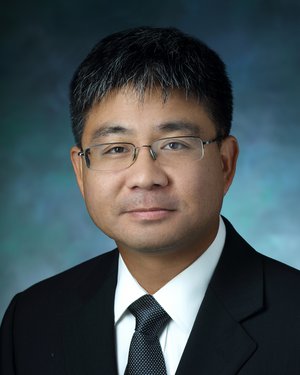The Radiological Physics Division (RPD) was initially established in July 2002 as the Division of Medical Imaging Physics (DMIP) with the recruitment of Benjamin Tsui and his 14 associates — in 2018, George Sgouros became director of the division. It was rebranded as the Radiological Physics Division to expand its mission beyond imaging so that all of radiological physics, including radionuclide therapy is encompassed.
- Conduct state-of-the-art research in medical imaging physics, especially in the areas of nuclear medicine, including PET and SPECT, and X-ray imaging, including CT.
- Establish a graduate degree program in medical imaging physics within the Department of Radiology and Radiological Science.
- Provide physics education to residents, fellows and technologists.
- Provide clinical physics support to various clinical divisions of the Department of Radiology and Radiological Science.
Our Research
-
- Optimize radiopharmaceutical therapy (RPT).
- RPT dose and response modeling.
- Alpha-emitter RPT (αRPT), in vivo RBE evaluation in collaboration with Radiation Oncology SARRP facility.
- Develop and evaluate agents for alpha-RPT to treat a variety of cancers (breast, liver/liver mets, melanoma).
- Monolayer and spheroid response to DNA repair modulators with α-emitters.
-
- Imaging/dosimetry-driven clinical dose escalation trial of Y-90 microsphere therapy
- Treatment planning-based combination radiotherapy and αRPT for prostate cancer
- Treatment planning-based combination radiotherapy and radioiodine RPT for thyroid cancer
- Canine osteosarcoma αRPT trial
-
- Quantitative imaging and image quality optimization to assess therapeutic response in prostate cancer patients with skeletal metastases.
- Quantitative SPECT imaging of therapeutic radionuclides, including Ac-225, Ra-223, Pb-212 and Th-227
- Pediatric nuclear medicine imaging optimization
- Image-guided intervention and advanced ultrasound imaging to develop ultrasound-guided solutions for a variety of medical conditions.
- Task-based diagnostic image quality evaluation.
- Spectral, photon-counting-detector-based CT
- Acute ischemic stroke imaging using dual-energy CT
- Motion estimation and compensation for cardiac CT
- Iterative image reconstruction methods and task-based image quality evaluation for x-ray CT.
- Helical cone-beam CT
- Interventional soft tissue perfusion using x-ray system.
-
- Microscale dosimetry of alpha-emitters.
- RPT treatment and response simulations to translate preclinical model results towards human trial design optimization.
- NURBS phantom-based simulation of SPECT/CT imaging of nuclear medicine agents.
- NURBS phantom-based simulation of CT imaging for improved diagnosis of pancreatic cancer
- AI-based image reconstruction, quality assessment, response evaluation.
-
- Ongoing development of patient-specific radiobiological dosimetry methods.
- Clinical trial evaluation of absorbed dose vs response.
- Uncertainty evaluation for radiopharmaceutical dosimetry chain.
-
- Develop strategies that better communicate radiation doses and risks with patients and staff.
Education Programs
Master’s in Medical Physics
The program is designed for full-time students who wish to pursue a career as a medical physicist either as a researcher, as a certified clinical professional, or in industry. The program will require successful completion of a minimum of 38 credits for Master’s degree and completion of a research thesis (in conjunction with one or more of the faculty). Full-time master’s students will complete the program in two years.
Prospective Postdocs
The Division employs a number of postdoctoral fellows working on research projects funded by research grants and contracts. Most of the research projects require significant technical skills and knowledge in physics, mathematics, computer science, radiobiology, dosimetry, engineering and/or medical physics. Excellent English language and communication skills are also essential. Applicants with previous skills directly related to the research projects of interest are strongly preferred.
Postdoctoral Fellowship applicants should contact the division faculty staff directly for availability in his/her lab. Previous postdoctoral fellows have gone on to careers in academia, clinical medical physics, and industry.
Post-doctoral position in radiopharmaceutical therapy of cancer
Our Team Faculty
George Sgouros, Ph.D.
Director and Professor

Eric Charles Frey, Ph.D.
Professor

Mahadevappa Mahesh, M.S., Ph.D.
Professor

Katsuyuki Taguchi, M.Sc., Ph.D.
Professor

Yong Du, M.S., Ph.D.
Associate Professor

Jingyan Xu, M.S., Ph.D.
Assistant Professor

Tahir Yusufaly, Ph.D.
Assistant Professor

Colin Paulbeck, Ph.D.
Diagnostic Medical Physicist

Troy Zhou, Ph.D.
Radiology Physics and Engineering, Chief Physicist

Junyu Chen, Ph.D.
Instructor

Xinyuan Miao, Ph.D.
Medical Physicist

Postdoctoral Fellows
- Mahmud Hasan, Ph.D.
- Donghyeon Lee, Ph.D.
- FNU Anupriya, Ph.D.
- Nouran Rashed Rushdi Zaid, Ph.D.
Staff
- Zhi Li, Ph.D., Sr. Research Specialist
- Debbie Race, B.S., Administrative Specialist, Master’s Program Administrator
- Allison Cartee, B.S.
Graduate Students
Shalini Subramanian
Ph.D. student
Biomedical Engineering
(K. Taguchi/advisor)
Michael Blamires
M.S. student
Medical Physics
Scarlett Wei
Ph.D. student
Biomedical Engineering
(K. Taguchi/advisor)
Sizhuo Meng
M.S. Student
Medical Physics
Katie Kelly
M.S. student
Medical Physics
Affiliated Faculty
- Brian Caffo, Ph.D., Associate Professor, Johns Hopkins School of Public Health
- Jonathan Links, Ph.D., Joint Appointment in Emergency Medicine
External
- George Fung, Ph.D., Assistant Professor
Contact Information
Radiological Physics Division
Russell H. Morgan Department of Radiology and Radiological Science
Johns Hopkins Medical Institutions
601 N. Caroline St.
JHOC Room 4263
Baltimore, MD 21287
Contact our administrative coordinator:
Phone: 443-287-2425
